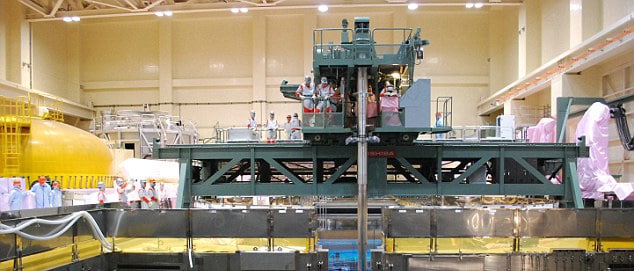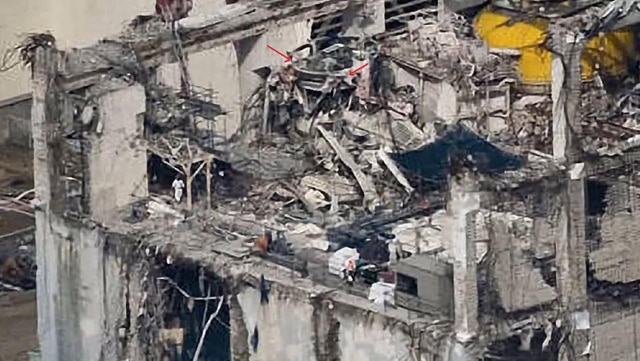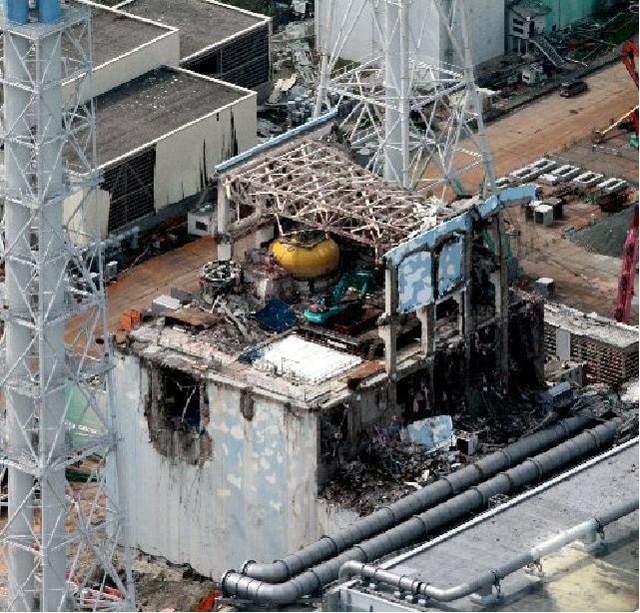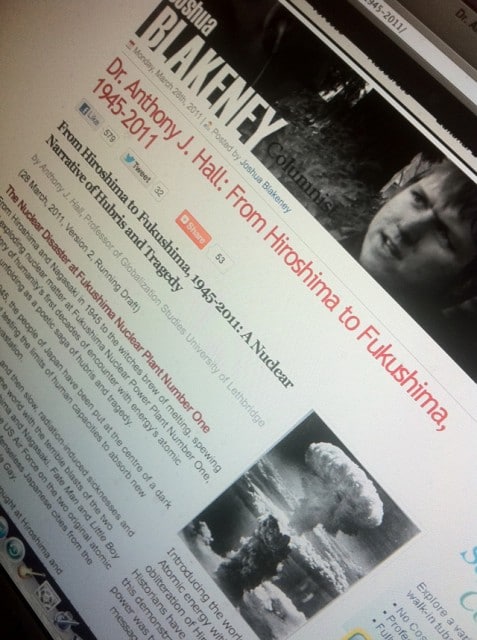DISCLOSURE: VT condemns the horrific tragedy committed by the NAZI Party against Jewish Citizens of Europe during Word War II known as the "Holocaust". VT condemns all racism, bigotry, hate speech, and violence. However, we are an open source uncensored journal and support the right of independent writers and commentors to express their voices; even if those voices are not mainstream as long as they do NOT openly call for violence. Please report any violations of comment policy to us immediately. Strong reader discretion is advised.
by Anthony Hall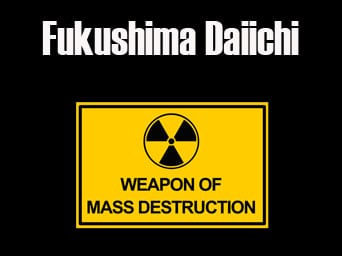
revised with a new photograph of the imperiled Unit 4, 6 July
“Our world is faced with a crisis that has never before been envisaged in its whole existence… The unleashed power of the atom has changed everything save our modes of thinking, and thus we drift towards unparalleled catastrophe.”
Albert Einstein, Bulletin of the Atomic Scientists, May, 1946
Albert Einstein’s Warning and the Ominous Fate of Fukushima Daiichi
As the bad news gradually spreads that the debacle at Fukushima nuclear power plant #1 is becoming more perilous rather than less so, the words of Albert Einstein come to mind. Recall that the legendary physicist, Einstein, helped to set in motion the Manhattan Project whose personnel designed and built the first atomic bombs dropped on Hiroshima and Nagasaki in 1945. In his letter to US President Franklin Delano Roosevelt in 1939 Einstein warned that if the United States did not enter and win the race to harness the destructive potential of atomic weaponry, Germany would almost certainly do so.
The Manhattan Project became a primary prototype for the Research and Development–R and D– partnerships linking the US government and for-profit corporations in what a Dwight D. Eisenhower would later describe as “the military-industrial complex.” Einstein himself did not directly participate in this huge initiative aimed at defeating the Axis powers linking Japan with Germany and Italy. One of the twentieth century’s most iconographic thinkers watched from the sidelines as other physicists and technologists applied many of Einstein’s theories to the building of atomic weaponry.
After Japan lay in ruins, not only from the atomic destruction of Hiroshima and Nagasaki but also from the massive carpet bombing of Tokyo and several other urban centers, Einstein went public with his fears and anxieties. In famous passages that have been subject to various translations and paraphrasing Einstein observed, “Our world is faced with a crisis that has never before been envisaged in its whole existence… The unleashed power of the atom has changed everything save our modes of thinking, and thus we drift towards unparalleled catastrophe.”

Japan as Laboratory
There have been many previews of the catastrophe anticipated by Einstein in the period after 1945 and before the March 3, 2011, 3/3/11, the day an earthquake and tsunami set in motion a chain reaction of interconnected crises that ruined Japan’s oldest operating nuclear power plant. The evidence grows every day that this local incident extends to national, regional and global chain reactions that one way or another will end Japan as we have known it and will transform our world in ways that are difficult even to imagine at this early stage of the crisis.
The direction and quality of this transformation depends very much on whether we can transform our way of thinking to adapt to the transformations brought about by our explorers of science and the innovators of technology that travel in their wake. By charting a course heading deep into inner space and tapping the volatile energy sources emanating from matter’s molecular constitution our civilization has been altered in ways that put us face to face with Einstein’s prophecy.
The four-decades-old installation on Japan’s eastern coast was at the moment of Fukushima #1’s destruction a virtual museum of nuclear technology. The design of the six GE Mark I reactors had been lifted from that of the power plant developed in the early 1950s for the US Navy’s first nuclear submarine.
As the tsunami hit, one of these antique GE reactors, number 3, was filled with the newest generation of plutonium-laced Aveda MOX fuel rods. A basic ingredient of nuclear bombs, plutonium isotypes are sprinkled among the 500 or so radionuclides currently being spread into air, ocean and groundwater from the massive explosions that transformed the Fukushima Daiichi power plant into the world’s largest and most menacing nuclear weapon.
In Japanese daiichi means number one. Fukushimi nuclear power plant #2, Fukushima Daini, is also situated on the Pacific coast about seven miles closer to Tokyo than Fukushima #1. Fukushima #2 also incurred major damage on 3/3/11. Presently all 54 nuclear power plants in Japan save one are completely shut down.
There is every reason to suspect that the vital information about the full extent of the nuclear disaster in Japan is still being kept from the public; that the life-threatening damage to Japan’s nuclear infrastructure does not end with Fukushima #1. The lack of public trust in an industry notorious for its lies, secrecy, military underpinnings, and lack of credible regulation is infusing resolve into the growing movement within Japan and around the world demanding that the nuclear power grid in one of the world’s most unstable geological regions should never be switched back on.
The growing evidence of increased frequency and severity of earthquakes in Japan with attending tsunami dangers adds urgency to the argument for the permanent decommissioning of nuclear installations that should never have been built in the first place. Some fundamental shift seems to taken place in the tectonic plates underlying this unstable region.
The Fukushima Debacle is Only in Its Infantcy
The growing realization that the worst of the Fukushima debacle lies in the future rather than in the past puts in sharp relief the pertinence of Einstein’s observation. Indeed, the prophetic nature of Einstein’s warning is starkly reflected in the failure of so many in government, in the media, in the academy, and especially in the richly-funded inner sanctums of the nuclear industry to respond appropriately to the terrifying implications of what is going so terribly wrong at Japan’s spewing Fukushima #1 power plant.
Rooted in old and outmoded motifs of perception, officialdom’s failure to identify the proliferating menaces in this unprecedented convergence of circumstances has extremely grave implications. What is being done and, more importantly, what is not being done at Fukushima nuclear plant #1 tragically illustrates Albert Einstein’s pivotal observation that the unleashed power of the atom has changed everything save our old ways of thinking.
A major obstacle blocking proper perception of the Fukushima debacle’s true nature has its origins in a propaganda meme going back to the 1950s. Initiated by US President Dwight D. Eisenhower with his “Atoms for Peace” speech at the United Nations in late 1953, this propaganda meme seeks to disassociate entirely the dual compartments within the nuclear industry.
While the global public has been fooled into thinking that the supposedly civilian branch of the nuclear industry is totally separate from its dominant military branch, this distinction is really a phantom.From its inception the deployment of nuclear energy to generate electricity was designed to give PR cover to the hugely lucrative and totally immoral business of building nuclear weapons. Indeed, to this day the bomb builders draw some of their ingredients such as tritium for their weapons of mass destruction for the operation of nuclear power plants.
http://www.timesfreepress.com/news/2010/feb/03/sequoyah-to-produce-bomb-grade-material/
The façade of duality makes it difficult to see what is really transpiring at Fukushima. At Fukushima we are witnessing an installation built for the seemingly benign purpose of generating electric power suddenly transformed into a stationary weapon piled high with fissionable material with far more potential for mass destruction than a vast arsenal of large nuclear bombs.
Radioactivity as a Slow But Sure Weapon of Mass Destruction
In order to face squarely the hard truths of what is transpiring at Fukushima, it is necessary to possess some understanding of the powerful effects that many different forms of nuclear radioactivity have on life’s cyclical renewal. While radiation itself is as old as the universe, the capacity of human beings to generate this force of nature through the power of nuclear technology is something new under the sun.
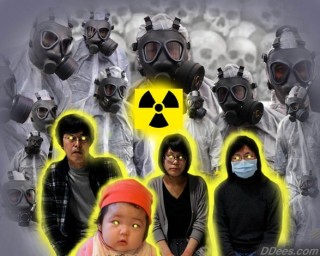 Humanity’s new means of unleashing energies with godlike agency to alter life’s genetic blueprints, the very DNA of existence, forms by far the most consequential of the changes that Einstein warned us about. The stunning failure of Japanese and international responses so far to Fukushima’s radioactive emissions—emissions that could skyrocket at any moment beyond the wallop of what would be emitted from a full-fledged nuclear war — constitutes a tragic confirmation of Einstein’s worst fears. More than any other crisis to date, the nuclear debacle at Fukushima illustrates the failure of our species, but especially those who put themselves forward as our leaders, to adapt old ways of thinking to the changes ushered in by the splitting of the atom.
Humanity’s new means of unleashing energies with godlike agency to alter life’s genetic blueprints, the very DNA of existence, forms by far the most consequential of the changes that Einstein warned us about. The stunning failure of Japanese and international responses so far to Fukushima’s radioactive emissions—emissions that could skyrocket at any moment beyond the wallop of what would be emitted from a full-fledged nuclear war — constitutes a tragic confirmation of Einstein’s worst fears. More than any other crisis to date, the nuclear debacle at Fukushima illustrates the failure of our species, but especially those who put themselves forward as our leaders, to adapt old ways of thinking to the changes ushered in by the splitting of the atom.
The science of measuring and understanding the effects of radioactivity on biological transformations is still in its infancy. Nevertheless since 1945 the tendency has been for promoters of applied nuclear power to deny, negate, or downplay the effects of radioactivity on life’s natural patterns of renewal. This culture of denial has its origins in the official response of US government officials to the radioactive contamination of all people, plants and animals that survived the first wave of destruction from the bombing of Hiroshima and Nagasaki. This unwillingness to contend with the effects of radioactivity on the public health of large population groups was captured in a headline in The New York Times on September 13, 1945. That headline proclaimed, “No Radioactivity in Hiroshima Ruin.”
http://japanfocus.org/-Gayle-Greene/3672
Through the decades that followed the inception of the Nuclear Age in the A-bombing by the US government of Japanese civilians, the formal position of officialdom has hardly shifted at all. Again and again we have been reassured that the public health effects of industrially-generated radioactivity are negligible no matter what the source. Again and again public funding has been directed to convincing us that there is no need to fear, for instance, nuclear testing in the atmosphere; the mining, processing and manufacturing of nuclear products including nuclear weapons; the deployment of nuclear energy for the generation of electricity and for the propulsion of ships and submarines.
Not surprisingly this same pattern of disinformation is being tragically repeated in the failure to depict the Fukushima nuclear catastrophe as the true monstrosity of an emergency it really is. The system of professional malfeasance originated in 1945 is being extended to the Fukushima cover-up by nuclear industry officials as well as those in government, media and the academy who have allowed themselves to become their criminal accomplices. What are the legal implications of withholding from the public the information we need to do the best we can to protect ourselves, our families and our communities from potentially lethal assaults on our health?
This ongoing propensity of officialdom to downplay the effects of nuclear contamination is similar to the decades-long history of the tobacco industry’s stonewalling. Who can any longer be blind to the tobacco industry’s efforts to deny the mountains of evidence proving that smoking has major deleterious effects on human health?
A more recent equivalent is the campaign of the old, entrenched and sumptuously-funded lobby of Big Oil to deny that the massive burning of its main product over generations is affecting the global atmosphere. The other side of this same coin involves the suspicion that some of the big backers of the nuclear industry have covertly contributed to overinflating the political balloon of global warming in order to make nuclear power plants look like the green alternative to the fossil fuel industry.

Who Are the Credible Sources?
Although the mainstream media has been largely AWOL on the Fukushima story, a number of conscientious authorities in the field of nuclear energy have come forward to explain the emergency in venues like Russia Today. These learned experts include Arnold Gundersen, Christopher Busby, Helen Caldicott, and Michio Kaku. Other officials, including at least two Japanese ambassadors and the Japanese emperor himself, have added their voices to point out the severity and unremedied character of the ongoing Fukushima crisis. For instance Akio Matsumuru, who regularly represents Japan at UN-sponsored conferences, issued a report dated June 11, 2012. Among the many alarm bells he rings, Matsumuru calls attention to the possibility that the phenomenon known colloquially as the China Syndrome is close at hand if it is not already occurring. Matsumuru observes,
1. In reactors 1, 2 and 3, complete core meltdowns have occurred. Japanese authorities have admitted the possibility that the fuel may have melted through the bottom of the reactor core vessels. It is speculated that this might lead to unintended criticality (resumption of the chain reaction) or a powerful steam explosion – either event could lead to major new releases of radioactivity into the environment.
2. Reactors 1 and 3 are sites of particularly intense penetrating radiation, making those areas unapproachable. As a result, reinforcement repairs have not yet been done since the Fukushima accident. The ability of these structures to withstand a strong aftershock earthquake is uncertain.
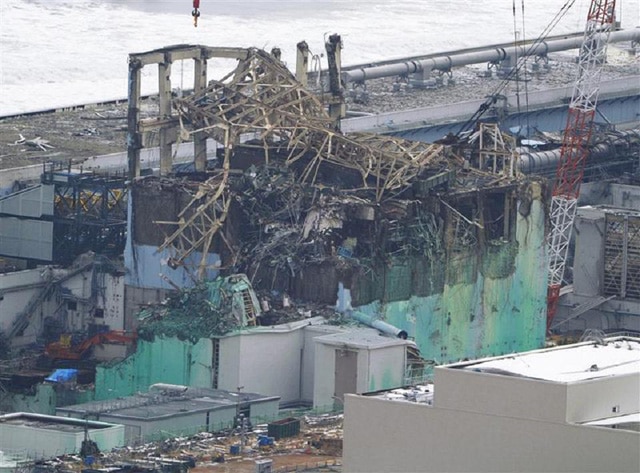
http://akiomatsumura.com/2012/06/what-is-the-united-states-government-waiting-for.html
While more and more very serious crises are identified every day, the chorus of voices keeps growing pointing to the catastrophe of catastrophes poised to happen at reactor number 4. Mitsuhei Murata, the former Japanese Ambassador to Switzerland, minced no words in pointing out what he considers to be the main impending danger to the UN General Secretary. Murata asserted “It is no exaggeration to say that the fate of Japan and the whole world depends on No. 4 reactor
The four images above are all of structure number 4, the ruin containing one of the 7 damaged cooling pool holding over 4,000 tons of highly radioactive spent nuclear fuel rods at Fukushima #1. This hulk of a structure is not expected to survive another significant earthquake. If the shock of another earthquake results in the spilling of this already-decimated structure’s radioactive cargo into the open air, it is predicted by a number of experts in the field that a radioactive bonfire will ensue that will be the slow-motion equivalent of a major nuclear war. Notice the large round bright yellow structure that appears in all four photographs, including the first one taken of the cooling pool above reactor number 4 before 3/3/11. Consider the obvious design stupidity that situates the cooling pool for spent nuclear fuel rods 100 feet in the air.
—————————————————————————————————
The diplomat was commenting on the precarious state of the spent waste pool held 100 feet in the air by a blown-out structure that quite likely would collapse along with many tons of nuclear waste if another earthquake was to occur. The further break up of the already severely damaged “cooling pool” would lead to a huge radioactive fire that would burn for perhaps a century releasing dozens of the most toxic radionuclides known to science into air, ocean and groundwater.
Ron Wyden, a Senator representing the US state of Oregon, echoed similar sentiments after having himself inspected the Fukushima site. He observed,
The scope of damage to the plants and to the surrounding area was far beyond what I expected and the scope of the challenges to the utility owner, the government of Japan, and to the people of the region are daunting. The precarious status of the Fukushima Daiichi nuclear units and the risk presented by the enormous inventory of radioactive materials and spent fuel in the event of further earthquake threats should be of concern to all and a focus of greater international support and assistance.
http://www.naturalnews.com/035813_Ron_Wyden_Fukushima_radiation.html#ixzz1xWqfblUu
Since the first days of the crisis Alexander Higgins has been one of the most persistent, precise, and attentive bloggers regularly reporting on and interpreting the growing body of evidence that something truly terrible is going on at Fukushima #1. One of his headlines reports that the Fukushima catastrophe has already released into air, ocean and groundwater 4023 times the amount of deadly radioactive cesium than the fallout from the Hiroshima attack. Another headline reads, “Fukushima is Continually Blasting All of Us With High Levels of Cesium, Strontium and Plutonium and Will Slowly Kill Millions for Years to Come.”
The assault of radionuclides on human beings includes air-born, alpha-ray emitting nuclear particles that can find their way into our lungs, bones, muscles, and blood. The same forces of nuclear contamination assaulting us is are concurrently attacking our plant and animal relatives, some of whom we eat. The process of bigger creatures eating smaller creatures tends to increase the concentration of toxic contamination, including nuclear contamination, the higher one gets up in the food chain all the way to the lordly place inhabited by human omnivores.
The massive nuclear contamination of the Pacific Ocean is perhaps the wildest of the wild cards being dealt to us by the Fukushima debacle . The aquatic life in the Pacific Ocean has been an especially huge and prolific source of food for some of the most densely-populated zones of human habitation on the planet including Japan, China, Indochina, Australasia, and the Western Hemisphere. The discovery of radioactive tuna and radioactive kelp in California, not to mention weird sickness showing up among seals and walruses in Alaska, is without doubt but a small signal of bigger and badder things to come.
Like so much of the front line work of necessary investigation these days, most of the discovery of the awkward truths on the frontiers of Fukushima’s creeping effects on the ecology of life are being made private citizens rather than government officials. By and large the response to the Fukushima debacle of most governments, including my own Canadian government, has been to shut down monitoring programs and to lower the bar of minimal standards so a false patina of normalcy can be maintained.
The contamination in the oceans is matched by discoveries of traces of radionuclides in milk, eggs, meat, vegetables and fruit products. Even the fall of sweet rains have been contaminated. What happens to our inner sources of spiritual renewal when we can no longer seek without worry the healing forces of cleansing walks in the spring rains or the dawn mists?
 Higgins tends to be especially quick to draw attention to those many instances when the Toyko Electric Power Corporation, TEPCO, revises data released in its own previous reports. Almost always these revisions reveal that TEPCO was initially lowballing its assessment of the extent of the interconnected catastrophes.
Higgins tends to be especially quick to draw attention to those many instances when the Toyko Electric Power Corporation, TEPCO, revises data released in its own previous reports. Almost always these revisions reveal that TEPCO was initially lowballing its assessment of the extent of the interconnected catastrophes.
TEPCO was Fukushima #1’s “owner” prior to the 3/3/11 catastrophe. In spite of all the many well-documented instances of fraud and malfeasance in the lead-up to the Fukushima disaster, TEPCO inexplicably remains in charge of the supposed remedial operations at the devastated facility. So far TEPCO continues to prohibit third-party scientific observers from monitoring on site what is or is not being done. The company will not allow such observers to conduct their own independent studies of the true state of conditions at Fukushima #1.
Significantly Bloomberg News reported shortly after 3/3/11 that TEPCO’s level of liability to citizens and companies effected by the disaster goes only as high as $2.1 billion, a pittance under these horrific circumstances. As it now stands this amount could be reduced to zero if TEPCO can convince a Japanese judge that the debacle arises from an act of God.
As is so often the case when it comes to socializing the risk of dangerous industrial and military activities even as profits are privatized, the unwillingness of insurance companies to cover the corporate operators of nuclear power plants makes the governments and people of the host countries the real carriers of the huge risks accompanying the generation of electricity through nuclear fission.
Scientific Rationality Meets Insane-Asylum Irrationality
In one of Higgins’ early corrections he points out that TEPCO’s estimate that there is 1,760 tons of fresh and spent nuclear fuel at Fukushima is off the mark by over 200%. The subsequent figure released by TEPCO indicates that Fukushima #1 holds 4,277 tons of nuclear fuel rods, most of it nuclear waste stored in 7 cooling pools. All these cooling pools are now damaged and crippled to greater or lesser extents. After the earthquake and tsunami the whole industrial catastrophe at Fukushima #1 started with the breakdown of the systems to pump flows of cooling water through pools of spent fuel rods. Without this procedure these highly radioactive rods overheat, catch on fire, and blow up in a chain reactions of nuclear criticality. These chain reactions are already far advanced and taking place, at least for those of us who are attentive, right before our eyes..
It is the magnitude of the vast pools of nuclear waste stored at Fukushima #1 and at many other nuclear power plants that give these installations the potential to become far more destructive than nuclear weapons. The so-called “pay loads “ of nuclear bombs are tiny compared with the thousands of tons of fissionable material stored not only at Fukushima but at most of the 500 or so nuclear power plants throughout the world. An awareness of the threat to public health– indeed to the health of all living creatures– posed by the release of even miniscule specks of this nuclear waste into air or water requires a genre of understanding that Einstein rightfully predicted would be in tragically short supply in a world where the stuff of human consciousness continues to fall far behind leaps in scientific discovery and technological transformation.
The tight juxtaposition at Fukushima #1 of so many separate facilities for burning nuclear fuel, processing nuclear waste, and storing nuclear waste embodies the weird marriage of scientific rationality and insane-asylum irrationality that is the hallmark of an industry founded in the military drive to expand the industrial frontiers of mass murder.
 This convoluted traffic jam of the most dangerous industrial procedures known to humankind is a formula for projecting chain reactions through thresholds of nuclear holocaust. The creation at Fukushima #1 of an environment tailor made for the transformation of small problems into huge problems through chain reactions reflects perhaps the core phenomena on which the nuclear industry is ultimately based. The key to releasing nuclear energy in both bombs or nuclear power plants is to start the proliferation of chain reactions at the molecular level of inner space.
This convoluted traffic jam of the most dangerous industrial procedures known to humankind is a formula for projecting chain reactions through thresholds of nuclear holocaust. The creation at Fukushima #1 of an environment tailor made for the transformation of small problems into huge problems through chain reactions reflects perhaps the core phenomena on which the nuclear industry is ultimately based. The key to releasing nuclear energy in both bombs or nuclear power plants is to start the proliferation of chain reactions at the molecular level of inner space.
In the the case of the six GE Mark I reactors at Fukushima #1 and at the 23 similar installations in the United States, this insanity extends to putting the devices for burning nuclear fuel literally underneath elevated cooling pools for storing the nuclear waste.
This design concept might make some limited sense in the context of the tight confines of nuclear submarines. In retrospect GE’s decision simply to inflate the basic prototype of the power plant developed in the 1950s for the Nautilus nuclear submarine, and to use this design in land-based stations for the transformation of nuclear power into electrical power, must surely rank as one of the most dubious cost-cutting measures of all time.
The heritage of the Fukushima catastrophe in the technology of nuclear submarines speaks to the constitution of much larger phenomena. So much of what passes for the so-called civilian economy is based on mere industrial spin-offs from the military political economy whose preeminence was entrenched in the course of the Cold War and is now accelerating in the further militarization of society in the name of fighting the all-purpose boogeyman of “terrorism.”
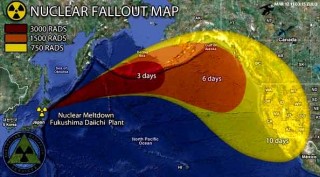 Sadly the thoroughly preventable catastrophe at Fukushima helps clarify the real sources of the most devastating terrors presently facing humankind. The transformation of Fukushima #1 into nuclear weapon #1 does not require a delivery system. The natural currents of the winds and the oceans are disseminating the radioactive toxicity more effectively that any missile, submarine, or secret Star Wars device.
Sadly the thoroughly preventable catastrophe at Fukushima helps clarify the real sources of the most devastating terrors presently facing humankind. The transformation of Fukushima #1 into nuclear weapon #1 does not require a delivery system. The natural currents of the winds and the oceans are disseminating the radioactive toxicity more effectively that any missile, submarine, or secret Star Wars device.
The startling images of the holding pools for nuclear waste at Fukushima #1 lethally exposed to the open atmosphere in the upper levels of the blasted-out hulks of wrecked nuclear containment sheds puts in clear public view the intellectual, technological and ethical poverty of an industry that has become a maniac of unnecessary risk taking. These images can be viewed as a terrifying caricatures of the outlandish extremes of deregulation combined with the privatization of society’s core public utilities. Here is stark evidence to suggest that Einstein may have not gone far enough in anticipating the madness of what would transpire after the genie of nuclear power was released from the lantern.
Nuclear Waste: The “Back End” of the Nuclear Cycle
Spent nuclear fuel rods emerge from the process of generating nuclear power in nuclear reactors. These rods contain thousands of pellets that contain many varieties of radioactive isotypes, some of which continue to be highly radioactive for millions or even billions of years. Among the most toxic and long-lived are some of the isotypes of cesium, strontium, uranium, americium, curium, and neptunium. Clearly there are vast technical problems entailed in isolating such varieties of nuclear waste from life’s fragile ecologies of interaction with earth, air, and water for periods of far longer than all of recorded human history. These problems have combined in ways that have long been recognized as the so-called Achilles heal of the nuclear energy industry.
http://coto2.wordpress.com/2011/03/26/us-stores-spent nuclear-fuel-rods-at-4-times-pool-capacity/
There are no valid reasons for using the sites where nuclear power is generated for the long-term storage of nuclear waste, the most dangerous genre of which is spent nuclear fuel rods. Indeed, the terrible catastrophe at Fukushima #1 demonstrates graphically the compelling reasons for not mixing these functions. This practice of combining the different stages in the industrial cycle of nuclear fuel developed not as a result of any properly conceived plan. It evolved, rather, as an ad hoc political expedient derived from the near-inevitable propensity of local inhabitants to mobilize public opinion against the building of facilities for permanent storage of nuclear waste in their regions, communities, and neighborhoods. This pattern gave rise to the development of a short-form term acronym used frequently and with disdain by some officials in the nuclear industry. That term is NIMBY—Not In My Backyard.
In my view there are deeper dimensions to the virtual abandonment by the nuclear industry (except, perhaps, in China) of initiatives to design, locate and build facilities specifically devoted to the task of permanently storing nuclear waste. Almost invariably any mobilization of citizens that starts with a NIMBY approach expands to provide a focus of public education and popular organization aimed at addressing the broader set of dangers connected to virtually every facet of the industry the produces both nuclear weapons and nuclear power plants.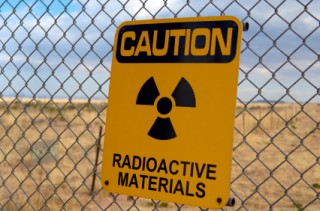
One of the strategies for avoiding the problem of having to deal with an organized opposition of informed citizens has been for the embattled nuclear industry to try to keep a low profile by letting nuclear waste accumulate out of sight and out of the public’s collective mind at nuclear power plants. The lack of enthusiasm within the nuclear industry to find viable and safe ways to dispose of nuclear waste goes back to the origins of the nuclear energy industry as a spin-off of military R and D. As Carol L. Wilson, the first General Manager of the US Atomic Energy Commission observed when he looked back at the beginnings of the industry from the perspective of 1979,
Chemists and chemical engineers were not interested in nuclear waste. It was not glamorous; there were no careers; it was messy; nobody got brownie points for caring about nuclear waste… There was no real interest or profit for dealing with the back end of the fuel cycle.
(Carrol L. Wilson, “Nuclear Energy: What Went Wrong?” Bulletin of Atomic Scientists, Vol. 35, June, 1979, 15)
Extending the Frontiers of Nuclear Energy
This multiplication and compounding of dangers by making the sites of operating nuclear reactors double as storage facilities for nuclear waste, including spent nuclear fuel rods that require constant cooling, finds its epicenter in the United States and particularly in the earthquake/tsunami zone of California. The spewing mess of simmering criticality at Fukushima #1 draws attention to other highly nuclearized jurisdictions like France and Ontario where nuclear power plants also double as storage facilities for the most dangerous varieties of nuclear waste.
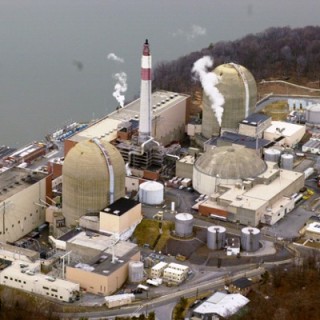
Officials admit to the storage of over 70,000 tons of spent nuclear fuel rods spread among the 104 “civilian” nuclear power plants in the United States. The continuation of this pattern of storing nuclear waste indefinitely at nuclear power plants has been called into question by a recent court ruling in New York. This court case arose from growing public antagonism to the operation of the Indian Point nuclear power plant in the midst of the urban megopolis of surrounding New York City. Almost 20 million people live within a 50-mile radius of this antique nuclear installation that is even older than Fukushima #1.
In the United States especially the military context of the so-called civilian branch of the nuclear industry is very clear. One of the biggest known accumulations of nuclear waste in the world is at the Hanover military reserve in Washington state where the assembly took place of the Fat Man and Little Boy bombs dropped on Hiroshima and Nagasaki. The Hanford reservation is the site of the storage facility for at least 53 million gallons of high-level nuclear waste.
The ongoing experimentation with nuclear energy continues by the US Armed Forces and its favoured stable of military contractors. This experimentation and the sometimes secret applications of its outcomes no doubt has large, if largely unacknowledged, consequences for the public health of many populations throughout the world but especially those in Eurasia. Elevated rates of cancer and human deformities imposed on humanity by the incursions of the military branch of the nuclear energy industry are most evident among the victims of depleted uranium attacks in Iraq. The tragedy inflicted on people there and in other afflicted populations will soon be showing up with more regularity as the short and long-term health effects of the Fukushima catastrophe begin to appear with more regularity in Japan, East Asia, North America, throughout the Northern Hemisphere, and across the world.
Some believe that the huge dark budgets directed towards the most covert branches of the national security state have given rise to the discovery of new scientific principles that have not yet been made public. Some of these discoveries may involve new ways of deploying nuclear energy in more targeted and covert ways. These new principles and the applied technologies flowing from them may, for instance, have been a factor in the near-instant transformation of the steel-framed Twin Towers into vapor and fine dust particles on 9/11. The obviously specious official cover story of the events of 9/11 has been instrumental in helping to infuse new life into old alignments of privilege and power that coalesced in the course of the Cold War.
Chernobyl, Fukushima, and the Dissolution of Empires
The nuclear catastrophe at Chernobyl in 1986 was without doubt was a contributing factor to the end of the Cold War. The disaster was one of several factors that contributed significantly to the implosion of public confidence within the Soviet Union to the pretensions of its governors. This loss of confidence and prestige translated into the tarnishing of USSR’s reputation and viability in the international community as well. Moreover, the nuclear explosion at Chernobyl undermined the self-justifying mythology of the Soviet state as a bastion of scientific reason expressing the dialectical materialism that Hegel and Karl Marx had characterized as the principal animating force of human history. The nuclear accident was perceived even within the Soviet government as a telling indictment of the Soviet system.
From the perspective of those who styled themselves as leaders of the “free world” the demise of the Soviet state entailed the sudden disappearance of enemy #1 with its accompanying justifications for the huge power, influence, and affluence of those overseeing the activities of the national security state and its attending military-industrial complex. The official 9/11 cover story quickly returned to old elites all the advantages of a global enemy to manufacture and fight even as it gave new elites the means of transforming local enemies into generic enemies of the so-called “West.”
It is instructive to compare the responses to the destruction of the nuclear power plants at Chernobyl and Fukushima. The mobilization of 800,000 Soviet citizens inside and outside the Armed Forces to put quite literally a lid on the massive devastation done in the heartland the the Ukrainian bread basket stands as one of the Soviet Union’s finest hours. A huge sarcophagus was constructed on the site of maximum radioactivity to put some obstacles in the way of a terrible plague of nuclear sickness, death, and intergenerational deformities that has probably extended to millions even as it is. How many more millions or tens of millions would have been contaminated if the sarcophagus had not been built?

So far the response to the Fukushima debacle has been entirely different. In the days following 3/3/11 the instant diagnosis of the nuclear industry’s spin doctors was that the accident was “more than Three Mile Island but less than Chernobyl.” Another spin was that some “partial meltdowns” might be taking place. I remember thinking that the idea of a partial meltdown made about as much sense as the idea of a partial pregnancy. Mostly the mainstream media swept the Fukushima story to the margins of coverage with many venues parroting the Japanese government’s disinformation that the Fukushima #1 had been put into “cold storage” sometime around December of 2011.
 As already noted, in some branches of the alternative media the coverage has been quite solid and quite equal to the magnitude of the Fukushima
As already noted, in some branches of the alternative media the coverage has been quite solid and quite equal to the magnitude of the Fukushima  catastrophe. There the assertions have gradually become more certain and confident that Fukushima’s potential for cataclysmic destruction vastly exceeds the extent of the Chernobyl debacle. Part of what makes the Fukushima crisis so menacing is the puny, incompetent, and frightened approach of those who keep TEPCO in the forefront, at least publically, of the official response to the worsening crisis. This is not to say that there has not been some heroic displays of courage, intelligence, innovation and self-sacrifice on the part of some individuals who tried to hold back the deluge of disaster. It is difficult to even imagine what it would mean to be in the their shoes.
catastrophe. There the assertions have gradually become more certain and confident that Fukushima’s potential for cataclysmic destruction vastly exceeds the extent of the Chernobyl debacle. Part of what makes the Fukushima crisis so menacing is the puny, incompetent, and frightened approach of those who keep TEPCO in the forefront, at least publically, of the official response to the worsening crisis. This is not to say that there has not been some heroic displays of courage, intelligence, innovation and self-sacrifice on the part of some individuals who tried to hold back the deluge of disaster. It is difficult to even imagine what it would mean to be in the their shoes.
But this ode to the best of the best of the first responders at Fukushima #1 does not in any substantial way mitigate my larger thesis that TEPCO’s corporate response to the crisis manifests the same malfeasance that created the conditions of the disaster in the first place. This unparalleled crisis, however, is about much more than TEPCO’s corporate inadequacies.
Ultimately I am saving my most concerted and targeted criticisms for those at the very top of the US-based nuclear industry, including officials in the US executive branch. These government and corporate officials cynically manoeuvred America’s most obedient formal and then informal colony to accept the nuclear energy spin-offs of American military technology when the Japanese people on their idyllic but earthquake-prone islands should never have been pressured to do so. It is in those circles of imperial power where real responsibility for the cataclysm resides even as it is in these same centres of authority from whence the major initiatives to contain the disaster should emanate.
The contrast between the Soviet response to Chernobly crisis and the corporatist response to the Fukushima crisis is therefore huge, telling and, ultimately, tremendously menacing for the future of human civilization let alone for the future of all life on earth. A small consolation is the lessons one can learn about the extent of the abandonment of any commitment to the public interest and the common good on the part of those who claim to be our leaders.
Does the worsening mess of mayhem and meltdown at Fukushima #1 embody the ailing American Empire’s Chernobyl moment?
Einstein versus Rickover
A major controversy is brewing inside and outside Japan about the decision of the government to transport radioactive debris from the Fukushima area for incineration in all parts of the country. There are several theories about why this is happening. One is that the government sees a great mass of law suits heading its way and is acting now to confound future scientific studies comparing the rates of cancer and the many other diseases in the most effected regions to the rates in less effected regions.
My view is that this irrational decision can be attributed to the entire Japanese society breaking down under the weight of one huge collapse after the next. The people of Japan have been traumatized by natural disasters of great magnitude. We must continually remind ourselves outside Japan of the stresses and strain that the natural disasters have imposed on the entire population. The grave failures of the Japanese government to respond appropriately to the Fukushima catastrophe need to considered through the lens of this consideration.
 A big part of the problem is that the response to the Fukushima debacle should be international in scope. Alternatively, the crisis should not be treated as a matter primarily for Japan’s domestic politics. This domestication of control over nuclear power plants, when the effects of what happens in them is so obviously transnational in nature, goes back to Albert Einstein’s fear that most human beings would not be able to adapt proactively to the vast transformations that would come from splitting of the atom.
A big part of the problem is that the response to the Fukushima debacle should be international in scope. Alternatively, the crisis should not be treated as a matter primarily for Japan’s domestic politics. This domestication of control over nuclear power plants, when the effects of what happens in them is so obviously transnational in nature, goes back to Albert Einstein’s fear that most human beings would not be able to adapt proactively to the vast transformations that would come from splitting of the atom.
Like Robert Oppenheimer and many of the other scientists employed by the Manhattan Project, Einstein was of the view that there were too many vast and unknown factors in the unleashing of atomic energy to allow this field of study to take place within the sovereign jurisdiction of individual countries. Einstein envisaged the need for the formation of a new kind of international entity that would closely guard nuclear secrets as well as closely oversee and regulate advances in nuclear science. The Einstein faction was especially adamant that the application of the principles of nuclear science to technological change was especially fraught. Such applications should be strictly prohibited until the the full consequences of every innovation was fully studied and properly understood.
The catastrophe at Fukushima and the lack of any concerted international response is a marker of the preemption of the Einstein faction by its detractors. Admiral Hymen G. Rickover, the US naval engineer who was put in charge of developing a nuclear submarine shortly after the Second World War, was the leader of the anti-Einstein faction. Once he developed the nuclear power plant for the Nautilus submarine Rickover turned his hand to developing land-based nuclear power plants for the generation of electricity.
Between 1954 and 1957 Rickover developed a model “civilian” nuclear energy plant in Shippingport Pennsylvania. He used that site as a teaching platform in a process of what he considered the democratization of knowledge and expertise in tapping the power of the atom. He efforts converged with a propaganda campaign mounted by President Dwight D. Eisenhower. In promoting “Atoms for Peace” Eisenhower sought to ease growing public trepidation on both sides of the Cold War that the escalating process of testing bigger and bigger nuclear weapons in the atmosphere seemed pointed towards nuclear holocaust through nuclear war.
The Atoms for Peace initiative was promoted particularly aggressively in Japan, a country whose people had and still have ample cause to reject anything associated with the atomic power given the attacks they have endured at Hiroshima and Nagasaki. These obstacles were overcome by the frontiersman of both the formal and informal empire of the United States.The US promotion of nuclear energy as a way of generating electricity became deeply integrated into the anti-communism that preoccupied US policy makers and their corporate clients like GE in that era. As planned, Japan was shaped into a bastion of containment to fend of the influences of Chinese Maoism. The presidency of former GE media spokesperson Ronald Reagan and the six GE nuclear reactors at Fukushima #1 were outgrowths of this saga.
Years later Admiral Rickover radically revised his view that nuclear power plants were benign instruments of peace and progress. When asked about the subject at the end of his career the engineer responded
Every Time you produce radiation you produce something that has a certain half-life, in some cases billions of years. I think the human race is going to wreck itself, and it is important to try to get control of this horrible force and try to eliminate it.. I do not believe that nuclear power is worth it if it creates radiation.
- https://www.veteranstodayarchives.com/2011/03/28/from-hiroshima-to-fukushima-1945-2011/

Anthony Hall is a Professor of Globalization Studies at the University of Lethbridge in Alberta Canada where he has taught for 25 years. Along with Kevin Barrett, Tony is co-host of False Flag Weekly News at No Lies Radio Network. Prof. Hall is also Editor In Chief of the American Herald Tribune. His recent books include The American Empire and the Fourth World as well as Earth into Property: Colonization, Decolonization and Capitalism. Both are peered reviewed academic texts published by McGill-Queen’s University Press. Prof. Hall is a contributor to both books edited by Dr. Barrett on the two false flag shootings in Paris in 2015.
Part II was selected by The Independent in the UK as one of the best books of 2010. The journal of the American Library Association called Earth into Property “a scholarly tour de force.”
One of the book’s features is to set 9/11 and the 9/11 Wars in the context of global history since 1492.
ATTENTION READERS
We See The World From All Sides and Want YOU To Be Fully InformedIn fact, intentional disinformation is a disgraceful scourge in media today. So to assuage any possible errant incorrect information posted herein, we strongly encourage you to seek corroboration from other non-VT sources before forming an educated opinion.
About VT - Policies & Disclosures - Comment Policy


